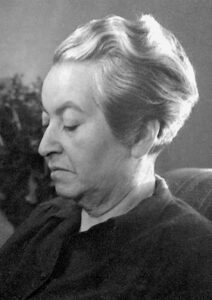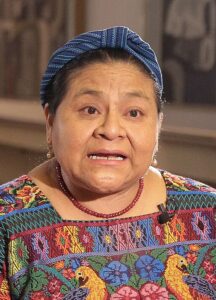As we approach International Women’s Day, and in honor of this holiday, we have compiled a list of five iconic Latinas who have been pioneers in their fields.
From politics to science to entertainment, these remarkable women have played an essential role in our culture and society.
So, in no particular order, here are five iconic Latina women who have shaped the world.
Gabriela Mistral

The first Latin woman included in this selection is Lucila Godoy Alcayaga (1889-1957), better known by her pseudonym Gabriela Mistral.
Chilean poet and educator Gabriela Mistral is considered one of the main references of Latin American literature of the 20th century; for her work, she won the Nobel Prize for Literature in 1945, which is the first recognition of a Latin American writer by the Swedish Academy.
Mistral was born on April 7, 1889 in a small town called Vicuña, in the Chilean Andes. Mistral’s father was a schoolteacher who wrote poems and sang to her on the guitar. It is said that her father – although estranged – and her grandmother inspired her love for literature and poetry.
For a long time, her education was based on random reading without any academic orientation. It was thanks to her curious mind, sharp intelligence and powerful sensitivity that the young woman made her way into teaching and the arts. In fact, over time she earned a reputation as a “national schoolteacher-mother”.
Her career as a writer began with the publication of powerful articles advocating for the rights of women, children, and disadvantaged groups. Throughout her life, Mistral worked as a consul, journalist, teacher, and poet, traveling the world as an ambassador of Chilean culture.
Her literary work included themes of Christian faith, pain and love. The publication of her first great collection of poems, Desolación (1922), gave Mistral international recognition and prestige, and she came to be considered one of the greatest literary promises of the time.
On November 15, 1945, she became the first Latin American to receive the Nobel Prize for Literature, “for her lyric poetry which, inspired by powerful emotions, has made her name a symbol of the idealistic aspirations of the entire Latin American world”.
A few years later, she also received the Chilean National Prize for Literature.
Frida Kahlo

We continue our list of iconic Latinas with Mexican painter of German descent, Magdalena Carmen Frida Kahlo y Calderón, better known as Frida Kahlo (1907-1954). The artist became an international symbol associated with self-improvement, feminism, and artistic brilliance.
Frida Kahlo was born on July 6, 1907 in Coyocoan, Mexico City, into a family of artists. At the age of six she became ill with polio and her right leg was permanently damaged. Frida spent much of her life in and out of hospitals, and her entire existence was deeply marked by physical pain.
On September 17, 1925, Kahlo was involved in a very serious road accident when the bus in which she was traveling was hit by a tram. The consequences were terrible for her: she was unable to walk for several months and underwent more than thirty surgeries. .
It was then that the Mexican artist began to paint in a self-taught way.
From isolation and rest, the self-portrait would become the pillar of her pictorial work. It is fair to say that the self-portrait was the way in which the young artist began to explore her existence, pain and identity.
As Kahlo once said, “I paint myself because I am often alone and I am the subject I know best.”
During her life and artistic career, Frida Kahlo rescued the roots of Mexican folk art through her work, her clothing and her ideologies. Among her creations, Self-Portrait with Thorn Necklace and Hummingbird, The Two Fridas, Self Portrait with Cropped Hair, Henry Ford Hospital, The Broken Column, and The Wounded Deer stand out.
Nearly 70 years after her death, Frida Kahlo’s work remains invigoratingly fresh. The Mexican artist’s legacy continues to inspire artists, feminists and Latin culture enthusiasts.
According to Janet Landay, curator of the Museum of Fine Arts, Houston,
“Kahlo made personal women’s experiences serious subjects for art, but because of their intense emotional content, her paintings transcend gender boundaries. Intimate and powerful, they demand that viewers – men and women – be moved by them.”
Rita Moreno

The third Latina woman we want to commemorate on this special occasion is the one and only Rita Moreno, whose birth name is Rosa Dolores Alverío.
The iconic Puerto Rican actress and singer has her name in the Guinness Book of Records as one of the few artists to have won all four major awards in the American entertainment industry.
Rita Moreno was born in Humacao, Puerto Rico on December 11, 1931. After her parents’ divorce, Moreno and her mother immigrated to New York to start a new life. Soon, she began studying dance and made small appearances on Broadway.
In her early days, Moreno was hired mainly to play whatever “ethnic” role the studios needed, whether she was Polynesian, Hawaiian, Filipina, Native American, or Egyptian.
In 1961, Rita Moreno was chosen to play the character of “Anita” in the film adaptation of the musical West Side Story. For her audacious performance, Moreno would become the first Latina to win an Oscar. In the years to come, the Puerto Rican would go on to become the only Latina – and one of only 19 people overall – to achieve the coveted “EGOT” status, meaning she was recognized with an Emmy, a Grammy, an Oscar and a Tony.
In 2004, the versatile artist received the Presidential Medal of Freedom awarded by George W. Bush, and in 2009 she was honored with the National Medal of Arts, presented by Barack Obama.
In her nearly 70-year career, Moreno has never stopped fighting for fair and accurate representation of Latinos in the media. At 92, her career continues to flourish, whether on stage, on the small screen, in film, and beyond.
Rigoberta Menchú

We continue our selection with the fearless activist Rigoberta Menchú Tum. The work of this Latina has contributed significantly to raising awareness of the struggles and rights of indigenous peoples, not only in Guatemala, but around the world.
In 1992, her efforts were recognized with the award of the Nobel Peace Prize, “for her struggle for social justice and ethno-cultural reconciliation based on respect for the rights of indigenous peoples.”
Rigoberta Menchú Tum was born on January 9, 1959 into a large peasant family in Chimel, a small town in the Guatemalan province of Quiché. Her early years were marked by the discrimination and misery suffered by Guatemala’s indigenous population.
At an early age, she became an activist in the local women’s rights movement and also joined the Catholic Church to advocate for urgent social reform. Soon, Menchú and her family’s activism would provoke relentless persecution by Guatemala’s military government.
Unfortunately, the civil war in her country (1960-1996) decimated her family. Many of her loved ones were killed by the army, which persecuted opponents of the regime.
“In 1979 one of her brothers was skinned and burned alive; on January 31, 1980 her father was executed by the army at the Spanish embassy and three months later her mother was kidnapped and murdered”.
In 1981, Menchú, marked by family tragedy, was forced to flee from Guatemala to Mexico and from there to France.
Once in exile, Menchú devoted herself to denouncing the grave situation in her country worldwide. It is worth noting that the Guatemalan woman gained international notoriety in 1983 with her autobiography Yo, Rigoberta Menchú (I, Rigoberta Menchú), in which she recounts in horrifying detail the barbarism and injustices committed by the Guatemalan army.
In 1992, at the young age of 33, Menchú won the Nobel Peace Prize, becoming the first indigenous Latin American woman to do so.
Isabel Allende

And to conclude our selection of iconic Latinas who have made history, let’s talk about the prolific Chilean writer and journalist, Isabel Allende Llona.
Throughout her career, she has written more than 26 books, which have been translated into more than 42 languages and sold more than 77 million copies.
Isabel Allende Llona was born on August 2, 1942 in Lima, Peru. She is considered a Chilean writer as her family moved to Santiago, Chile, when she was incredibly young and it was there that she forged her identity; the acclaimed writer states that her future as such was decided in 1973, with the military coup in which her uncle President Salvador Allende was overthrown.
And the fact is that, after the coup d’état in Chile in the early seventies, Isabel Allende was forced to emigrate to Caracas and start a new life. Once in Venezuela, she wrote for the newspaper El Nacional, worked in a school, and published her first work, The House of the Spirits (1985).
Allende took her first steps as a novelist with a letter she wrote to her sick grandfather. The letter would become a manuscript of her first novel, The House of the Spirits, a work that became an international phenomenon and was made into a film and theater production.
From that moment on, the Chilean writer decided to devote herself entirely to literature, developing a remarkable career.
Some of her works include Of Love and Shadows, Eva Luna, Two Words, The Infinite Plan, Daughter of Fortune, Portrait in Sepia, Zorro, Ines of My Soul, Island Beneath the Sea, Maya’s Notebook, Ripper, and The Japanese Lover.
Over the course of her life, Allende has received numerous awards for her work, including the XLI Bancarella Literary Award (Italy, 1993), the Chilean National Literature Prize (2010), the Hans Christian Andersen Prize for Literature (Odense, Denmark, 2012), the Medal of Freedom (United States, 2014), the National Book Award: National Book Foundation Medal for Distinguished Contribution to American Letters (United States of America, 2018).
Today, Isabel Allende is considered one of the most widely read Spanish-language authors in the world.
Images: Anna Riwkin-Brick, Guillermo Kahlo, Nationaal Archief, Carlos Rodriguez/ANDES and Lesekreis
